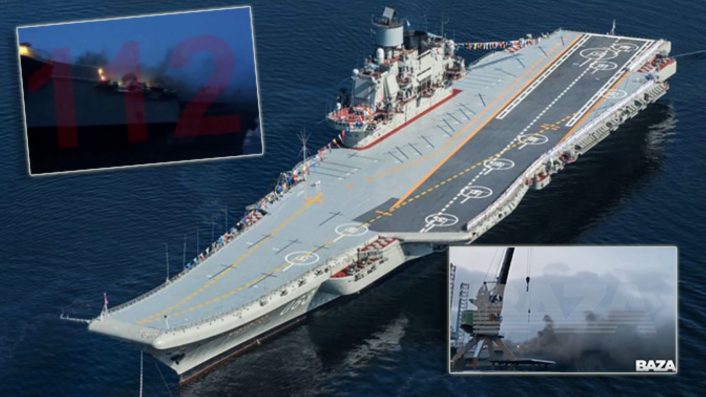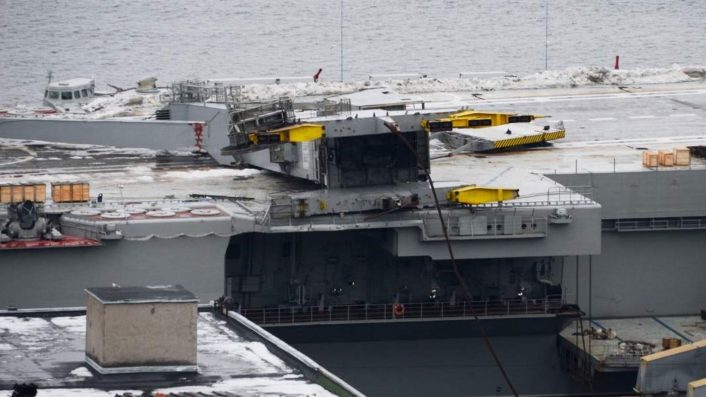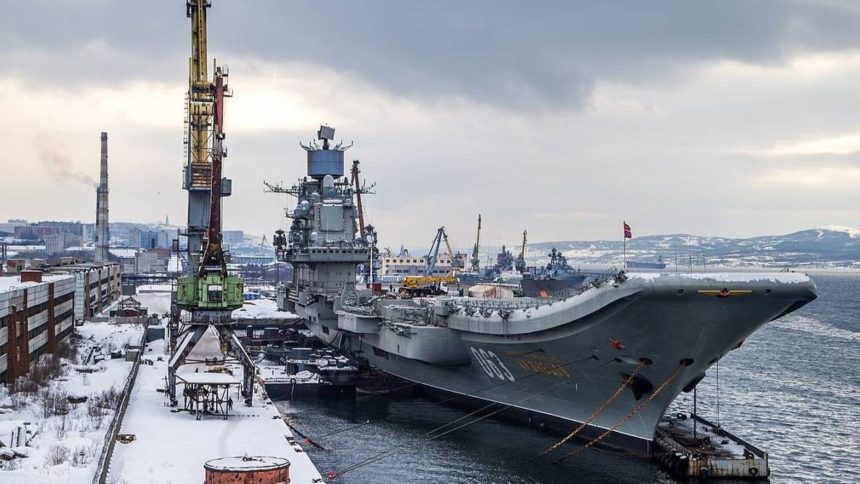The Admiral Kuznetsov aircraft carrier has suffered several accidents from 2009 to 2019, and has been undergoing overhaul and modernization works since 2017.
The Russian Navy is likely to pull the plug off the repairs that are keeping afloat its sole aircraft carrier, the Admiral Kuznetsov, ending a brief yet eventful era of Soviet naval aviation. Izvestia quoted Russian Navy, United Shipbuilding Corporation (USC) and Ministry of Defense (RuMoD) officials in deep background, who said the “physically outdated carrier may be decommissioned and sent for disposal,” while claiming its repair and maintenance has been suspended for a while.
The ship has suffered several accidents from 2009 to 2019. These include successive crashes of carrier-borne MiG-29 and Su-33 fighters in a span of weeks, fires owing to short circuits, welding and the simultaneous sinking of the PD-50 dry dock and a crash of a dock crane on the carrier’s deck.
Naval experts quoted by Izvestia are divided on their opinion about the relevance of an aircraft carrier, but the publication did report sentiment in the Russian Navy that advised against pouring resources in maintaining the ship. It must be noted that the RuMoD and the Russian Navy’s Main Command did not officially confirm to Izvestia the info about the decision, but former Russian naval commanders and experts reflect the thinking in the community.

‘Aircraft carrying cruiser’
Part of the Project 11435 class, the “Admiral of the Fleet of the Soviet Union Kuznetsov” aircraft carrier was laid down in April 1982 and launched on Dec. 6, 1985. The ship was commissioned into the Soviet Navy on Jan. 20, 1991, before becoming part of the new Russian Federation’s Navy after the dissolution of the Soviet Union.
The carrier was intended to be the lead ship of the Kuznetsov, with the other ship being the Varyag. The ship was still incomplete when the Soviet Union was disbanded and was thus left in Ukraine, where it was being built, only to be later sold to China and becoming the Liaoning, the PLA Navy’s first aircraft carrier.
The only one remaining of its class in Russia, the Admiral Kuznetsov was built as what was described by the Soviet Navy as an “aircraft carrying cruiser,” with 12 long-range anti-surface and anti-ship P-700 Granit missile launchers, right below the surface of the forward flight deck.
The missiles were added in order to circumvent the provisions of the Montreux Convention, which banned carriers heavier than 15,000 tonnes through the Straits. While it was initially planned to resume the ship’s operations in 2022, deadlines were “repeatedly postponed,” presumably owing to the war in Ukraine, beside the several incidents.
BRICS NEWS
Confirmed:
Russia’s Repair and modernization efforts for the heavy aircraft carrier Admiral Kuznetsov, ongoing for the past 7 years, have now been officially suspended by Russian authorities.
Simply pathetic.
— Astraia Intel 🇺🇦 (@astraiaintel) July 11, 2025
Recent troubles
The ship’s latest round of troubles began in April 2023, when Izvestia reported that the warship did not have any crew at the time, delaying the ship’s scheduled departure from the drydock at Sevmorput Shipyard in northern Russia’s Murmansk in February that year.
A machine translation said that identifying and training 1,500 personnel for the ship was proving to be “difficult.” The positions and trades included “sailors, warrant officers, officers, motormen, navigators and communications specialists.”
No ship in the Russian Navy fleet required such a large crew. At the time, it was estimated to return the ship to the Northern Fleet’s operations in 2024, after United Shipbuilding Corporation CEO Alexey Rakhmanov reported on Feb. 21, 2023 the “dock repairs on the underwater part of the ship” were completed. It was then moved to a permanent berthing area.
Beautiful photos of Admiral Kuznetsov aircraft carrier during its passage through the English channel, today. Via https://t.co/3Z1Xnu2Yep pic.twitter.com/POmTMleBWJ
— Naval Analyses (@D__Mitch) October 21, 2016
Former Pacific Fleet chief Admiral Sergei Avakyants told Izvestia that carriers are obsolete and the Russian Navy must sell it to scraps, if a decision is made not to continue repairs. He described the carrier as “very expensive and ineffective,” adding that “the future belongs to carriers of robotic systems and unmanned systems.”
Naval expert Ilya Kramnik from the Center for the Study of Strategic Planning, while differing on the relevance of aircraft carriers, admitted that the opinion in military circles is against further modernization and repair of the Admiral Kuznetsov. “This is a fairly old ship, it served in not the best years for our fleet, which did not add ‘youth’ to it. The cruiser has a fairly old design and not the most reliable, as operating experience has shown, power plant,” Kramnik explained.
Others, like Captain 1st Rank Vasily Dandykin and Kramnik, opine otherwise. This reflects the broad political and global strategic vision of the Russian state that never had expeditionary and power project goals, unlike the People’s Republic of China (PRC) and the United States.
Photos of the Admiral Kuznetsov in dry dock at the 35th SRZ.https://t.co/Fio5M72fqi pic.twitter.com/PHfMgIqmKE
— Rob Lee (@RALee85) August 9, 2022
Documents, like the ‘Fundamentals of State Policy in the Sphere of Naval Activity until 2030,’ recommend a carrier each for the Northern and Pacific Fleets, but Izvestia adds how the funding is a major problem given the ongoing war in Ukraine. Possibly, Russia might make a decision after the war and its outcome becomes clear.
Accidents and mishaps
The ill-fated carrier has seen a series of mishaps over the last few years, as we reported here at The Aviationist, beginning with two successive crashes of its carrier-borne jets. On Nov. 13, 2016, a MiG-29KUBR, one of the four naval Fulcrums assigned to the 100th Independent Shipborne Aviation Regiment, crashed while the carrier was operating in the eastern Mediterranean Sea off Syria, at the height of Russia’s involvement in the civil war on the side of deposed President Basher Al-Assad.
The pilot of the two-seater jet, part of a formation of three MiG-29s, ejected safely and was later rescued by the Kamov naval helicopters deployed onboard the carrier. Of the other two jets, one diverted to Syria while the other landed back on the carrier. The incident was particularly embarrassing as several NATO aircraft and warships closely monitored the operations.
В Мурманске загорелся крейсер «Адмирал Кузнецов» с людьми на борту https://t.co/5Uz17ZBZYU pic.twitter.com/7RXarjEeyE
— Flash Питер | Новости (@flashnord) December 12, 2019
Another crash followed within days, on Dec. 3, when a carrier-based Su-33 Flanker went down on its second attempt to land on the carrier, despite good weather conditions (visibility +10 kilometers, Sea State 4, wind at 12 knots). As we reported at the time, it initially appeared that the jet missed the arrestor wires and failed to go around, falling short of the warship’s bow.
The pilot successfully ejected and was picked up by a Russian Navy search and rescue helicopter. The Russian MoD subsequently confirmed the incident, saying that the arresting wires snapped and failed to stop the aircraft.
In the early hours of Oct. 30, 2018, while undergoing repairs at the 82nd Shipyard in Murmansk, the floating dry dock PD-50 sank and a crane crashed onto the carrier’s deck, tearing a gash up to 5 meters wide, Reuters reported. One of the biggest mishaps then took place on Dec. 12, 2019, when a blaze broke out aboard the carrier while it was at the Barents Sea’s port of Murmansk for repairs. United Shipbuilding Corporation chief Aleksey Rakhmanov then said in August 2020 that it would cost 350 million Rubles to repair the ship.

RT reported that six people were injured, while two sailors and one worker were unaccounted for. Sparked by welding, the fire engulfed a 600 square meter space, emergency services told TASS.
Prior to that, on Jan. 7, 2009, a small fire caused by a short circuit broke out while the Admiral Kuznetsov was anchored off Turkey during drills in the Mediterranean. One crew member was lost due to carbon monoxide poisoning. Rakhmanov told RT and Interfax that “a human factor” could be the cause.









